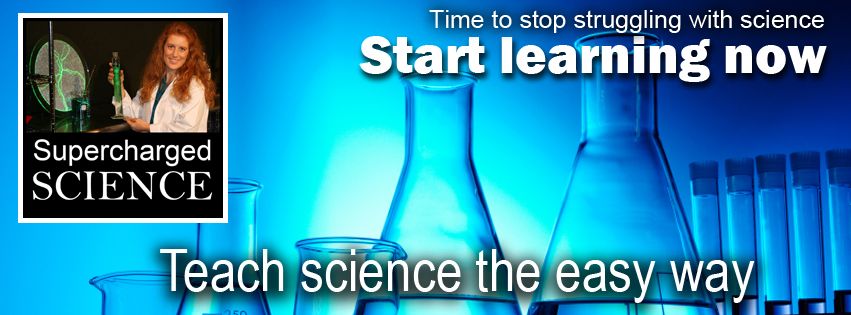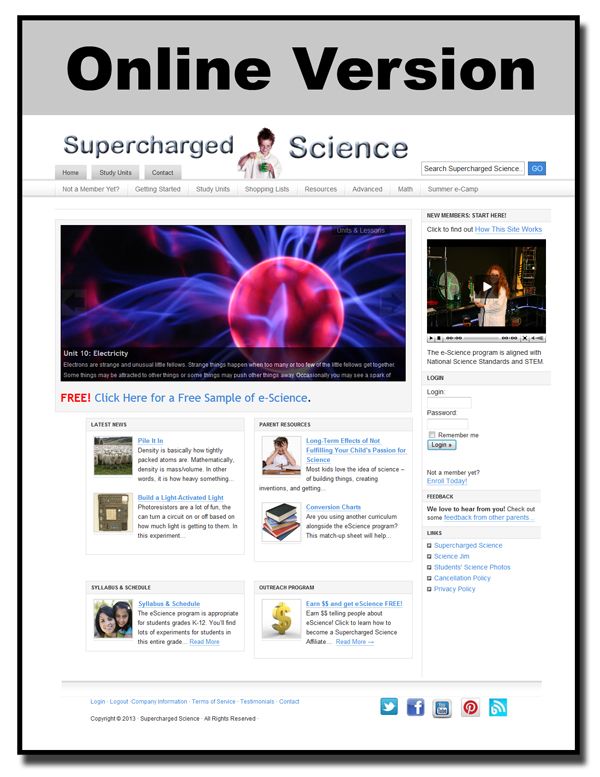
Supercharged Science's e-Science program is one of those gold standards that homeschoolers simply drool over. You find it early on when you start homeschooling, balk at the price (more on that later), but find yourself coming back to it over and over again. If you're smart, you tune into Aurora Lipper's frequent free teleclasses and realize that, for this curriculum, that higher-than-average price just might be well worth it. Not to reveal the final opinion at the beginning of the review, but not only is the price worth it - it's a bargain.
e-Science is the brainchild of a genius - no, the founder really is. Aurora Lipper is one of the youngest engineering instructors at Cal Poly State *ever*. She is also a real life rocket scientist. Does saying that ever get old? In spite of those credentials (haha), Aurora is the most engaging and entertaining teacher I have ever seen. I am one of those non-science people. I don't really like it. I definitely don't like teaching it. Aurora changes that for me. Because of her I don't have to teach it. Because of her I like it. She doesn't just make it fun - she makes it comprehensible which, to be honest, is way more important for me. Would e-Science be e-Science without Aurora Lipper? Maybe - she and her husband, Al, have set up an amazing program that is so thorough and well-organized that it could definitely be successful if they retired tomorrow. But the program has Aurora's mark all over it. She comments on all of the students' postings. Her enthusiasm jumps off every page. She *is* e-Science. When you buy e-Science, you get to participate in Aurora's love of science for a little while - and that gift is, for you and your children, priceless.
Purely Practical: What is e-Science?

e-Science is a group of 19 thematic units (plus Unit 0 - an overview unit), with unit 20 (Earth Science - yay!) on the way. When you subscribe to the website, you immediately gain access to the first 7 units. You then get access to another 2 units each month. If, however, you see a unit further down the list that you would really like to have access to, an email to customer service is all it takes to get it unlocked early.
Each unit contains between 60-80 experiments. The units can be navigated via the sidebar to the right, as seen below.
Each unit starts with a video introducing what will be studied - an overview presented by Aurora herself. The overview serves to whet the appetite. At this point, you have a lot of choices. You can take the traditional approach and do the reading. You can jump right into the experiments and do them. You can read through the experiment explanations and watch Aurora do them prior to doing them yourself. You can do any combination of these things. The program is 100% customizable, even down to how much time you spend on any one unit. You can cover the material lightly, choosing only a couple of experiments and eschewing much of the reading, in which case you can spend about a week per unit. I would not recommend this approach! Why would you spend the money for this amazing curriculum and for Aurora's talent and expertise and then not marinate in all she has to offer? Still, the program's flexibility is one of its attractions.
Doing all of the reading and all of the experiments can easily result in each unit's taking much longer. For high school, the level our review period focused on, the units can last a month or more. Each unit culminates in a quiz -- with answers provided! The best way to experience e-Science is to try it, which you can do here. I'm warning you, though, you're going to love it!
It is true that sometimes the high school level material can be difficult to find, but Aurora is actually working to make it easier for her customers (see the grade levels page under construction), and the fact is that most of the material can easily be used in conjunction with a high school program because it is so in-depth and hands-on. If you simply search the website for grades 9-12, you'll find tons of material designed just for these grades. When Aurora has material for high school students, she also includes high school textbook reading as well. It may take some ingenuity on the part of the parent (but, come on - we homeschool! It's what we do!), but this program can absolutely work as a high school program. Aurora will help you - customer service is one of her strongest attributes.
Therese and Chemistry
I have had a membership to e-Science before, and it broke my heart when I stopped subscribing. I have already decided (spoiler alert!) that even when our generous subscription ends, I'll move heaven and Earth to keep my subscription active. I'm selling my other science books (which I think are great, but they can't make my kids love science, and e-Science can) and letting Aurora make scientists out of my kids.
Because e-Science's high school content is marketed as being appropriate for gifted 5th-8th graders, I was anxious to see how it worked for Therese who, as a 6th grade aged 8th/9th grader, falls neatly into this category! After perusing the site a bit and talking with both Therese and her scientist father (a bio/chem guy),we decided to take the plunge and *do* chemistry. First up was ordering supplies.
*Important Caveat*: e-Science itself does not have to be expensive. At the younger grades especially, Aurora emphasizes using things you have around the house. I also used e-Science with my three younger kids, and we worked through units 1 and 2 only spending a few dollars while doing tons of great experiments (we used ping pong balls, clay, balloons, Popsicle sticks, etc. We only had to buy a small motor and propeller and a few other things).
Since we were approaching this as a Chemistry course, though, we knew that there would be a cost to ordering supplies. For each unit, a shopping list is provided. For Unit 8 (Chemistry), part of the shopping list looks like this:
For Grades 9-12:
Advanced Chemistry Kit All experiments in this
unit use chemicals from this kit.
OPTIONAL: Glassware Set If you don’t already
own glassware just for chemistry, we’ve found an
inexpensive set you can use all the way through
college. You’ll need to get denatured alcohol for the
burner. Note – if you’re going to continue onto to
Chemistry Part 2 in Unit 15, don’t get the optional
glassware and instead get the C3000 (see Unit 15
shop list).
Iodine Rainbow
Iodine (non-clear, non-ammonia)
Distilled white vinegar
Hydrogen peroxide (3% solution)
Turning Copper to Silver to Gold
Sodium Hydroxide
Zinc Powder
Table salt (a few tablespoons)
Vinegar (about a cup)
Pennies (minted after 1982)
Metal Tongs (these are not included in the optional
glassware set, so pick up a pair)
Beaker and Burner with Stand (both are included in
the glassware set mentioned above)
The two items in bold (my bolding added) were the big expenditures. Since we plan to move to Advanced Chemistry (unit 15) when we are done with unit 8, I appreciated Aurora's "heads up" about getting the more expensive set now.
After ordering, we only had to wait for the big box to arrive!
CHEM C3000 looked awesome.
After doing some background reading (I didn't make her do all of it!), Therese found the experiment that was the 9-12 alternative for the lower grades' first foray into acids and bases. It's explained in the wonderful manual that came with CHEM C3000 (that's how I think of it - kind of like a robot or something).
First, Therese watched Aurora perform the experiment.
Then, she set about making her own Sodium Hydroxide (with appropriate parental supervision, of course!)
The first time she poured out the contents of the Erlenmeyer flask the paper funnel collapsed and the experiment was not successful. On take 2, however, she had success! I will confess that it was hugely helpful having a bona fide scientist with us (the pater familias) who could explain everything that was happening, but he was absolutely not necessary (sorry, Honey!). Aurora explained everything perfectly.
In addition to walking Therese through experiments step-by-step, Aurora has also walked her through setting up a scientific journal. In fact, Aurora has dedicated an entire section of her website to the importance of the scientific journal. I so appreciate this, as scientific record keeping is not something with which I can help Therese, but I know how important it is.
What We Think of e-Science
In case it's not obvious, we love this program. My whole family, including that scientist husband, love it. Aurora is magnificent. The content is superb. The science is fun! The children learn! They beg to do science! (I know people say things like that in reviews all the time, but it is really true.) I am not going to let this program get away. There is so much to it that you really need to invest the time in visiting the website and sampling what is there. You'll fall in love with it. When considering the price, keep in mind that it is a full science curriculum for your whole family with more hands-on experimentation than you could ever hope to get from any other program.
So how much is it? For the K-8 portion of the site, the cost is $37/month. For all content, K-12, the cost is $57/month. There is never a commitment to stay and there is a 30 day money back guarantee. Try it for a month and you will never want to leave! How much is it worth to you to create a science-loving kid? Think scholarship opportunities, a trained and disciplined mind, and an intellectually curious child. I'm convinced that e-Science can inculcate all of those in willing kids. Aurora is offering an extra special sample for TOS readers right now, so be sure to check it out!













No comments:
Post a Comment